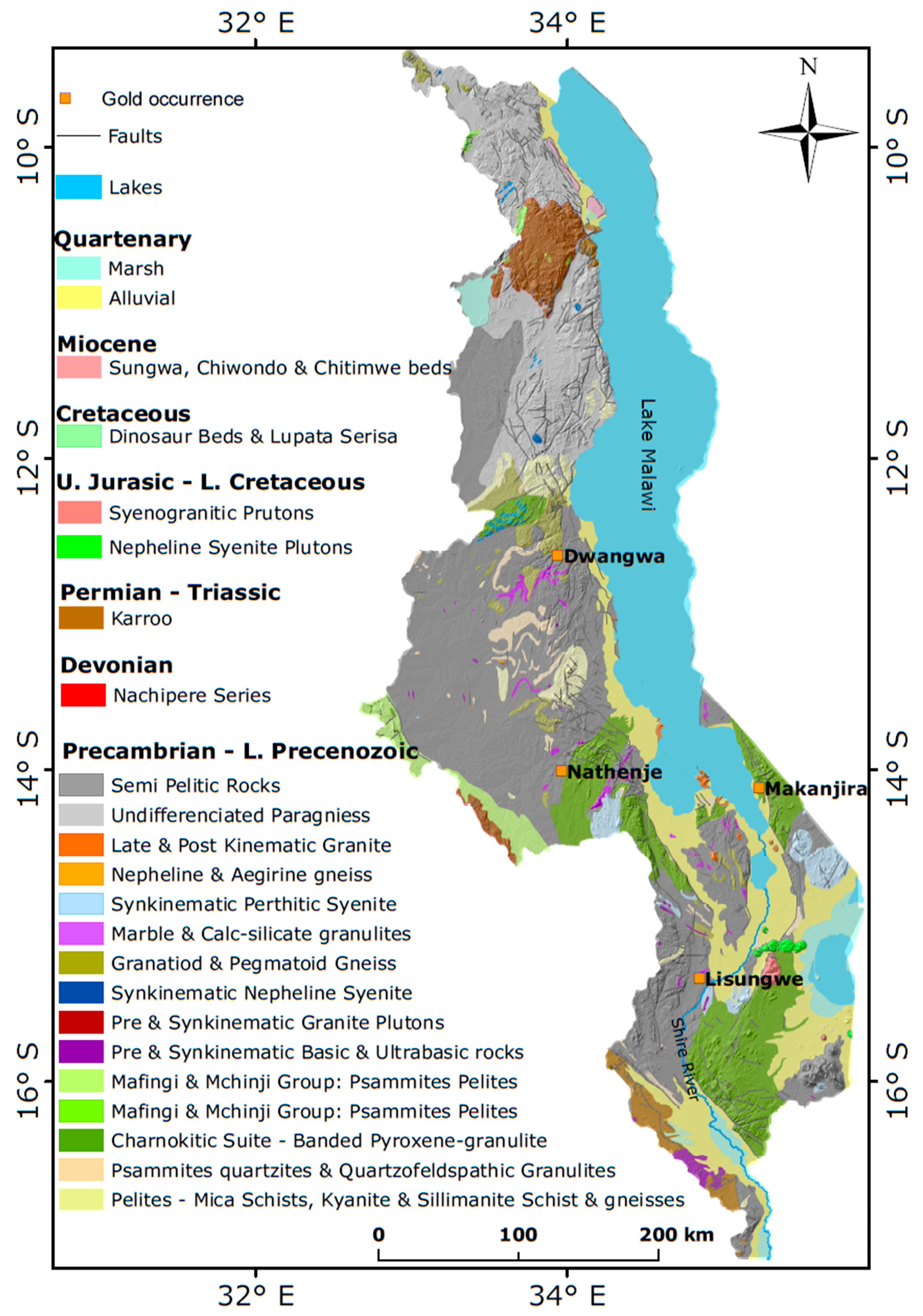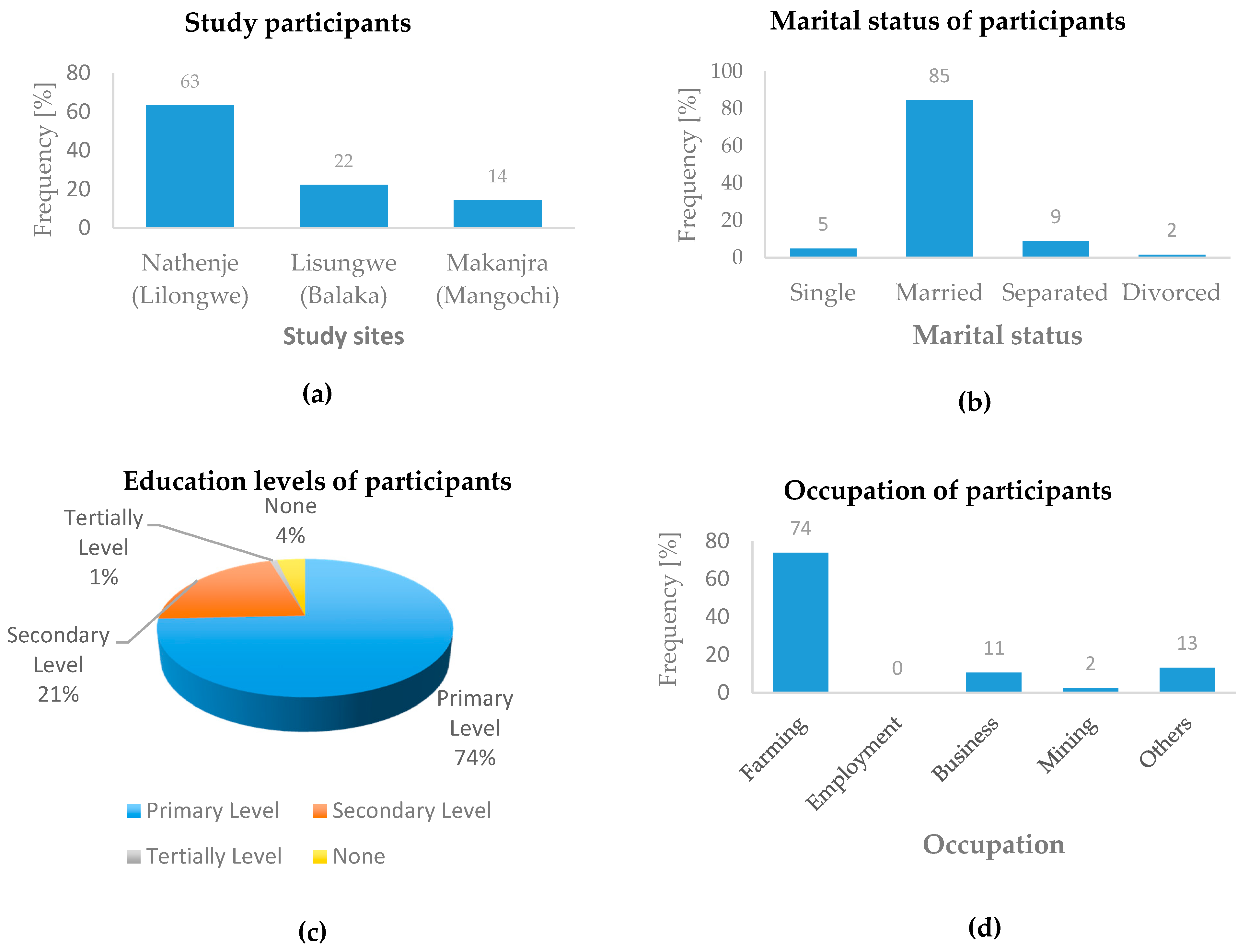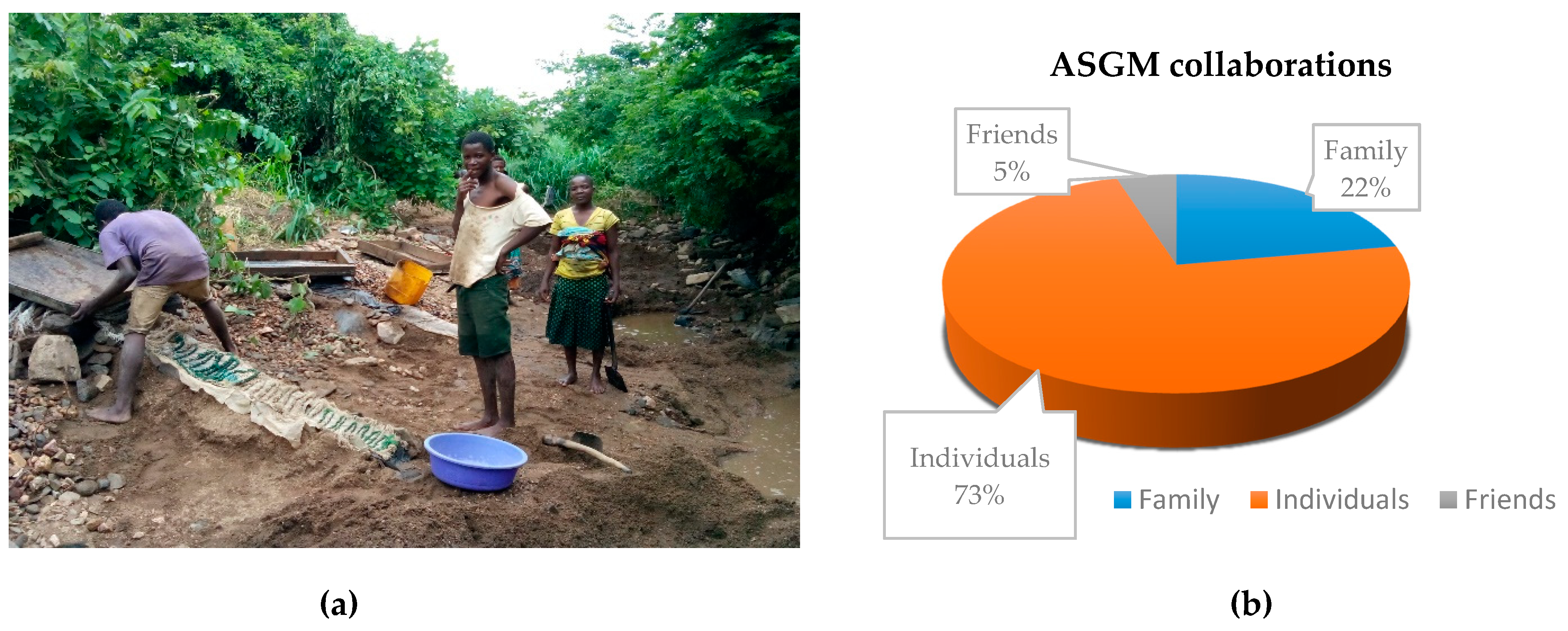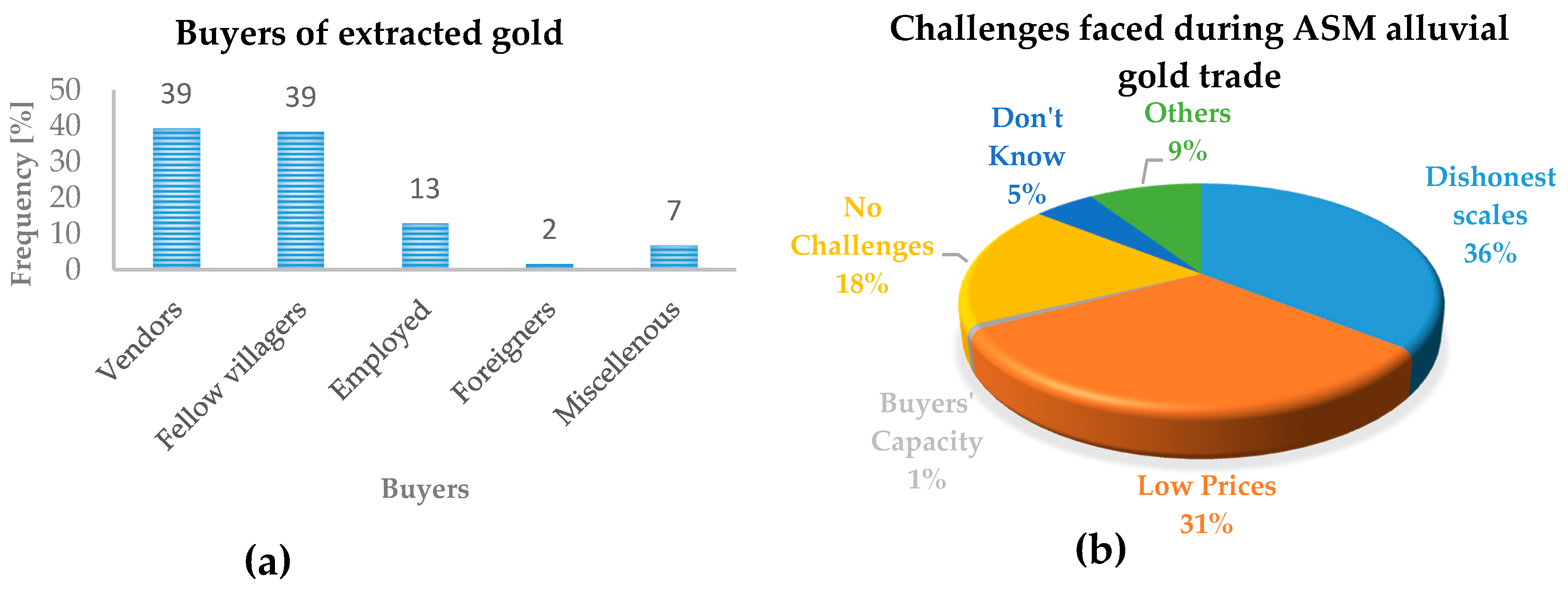An Investigation of the Socio-Economic Benefits of Small-Scale Gold Mining in Malawi
Abstract
:1. Introduction
1.1. Overview of Artisanal and Small-Scale Mining in Africa
1.2. Mining in Malawi
1.3. Study Area and Gold Occurrences
1.4. Geology of Gold Concurrency Areas
1.4.1. Nathenje Area
1.4.2. Kirk Range and Lisungwe Valley
1.4.3. Makanjira Area
1.5. Legislative Provisions
2. Materials and Methods
2.1. Study Sites
2.2. Study Design and Method
2.3. Study Populations and Its Characteristics
2.4. Sampling and Recruitment of Participants
- Recruitment of participants regardless of gender, and a single participant was picked from a household;
- Malawian citizens participating in the mining activities regardless of whether they were in-migrants of the area or not;
- Individuals who lived near the sites where ASM activities were taking place;
- Individuals who were actively participating in the ASGM activities either as workers, vendors or those selling food items and related materials around the mine sites
- Age range of 18 to 55 years
- Individuals with any level of income and education
- Residents of the immediate surrounding villages who were not participating in the mining activities
Sample Size of Participants
- n is sample size
- p is the percentage occurrence of a state or condition
- E is the percentage maximum error required
- z is the value corresponding to level of confidence required
3. Results and Discussions
3.1. Demographics
3.2. Summary of Site Observations
- Extraction of the alluvial gold ore situated at or near the surface
- The sites are located in remote and isolated locations, in mostly underdeveloped and far off townships
- Miners with low levels of education, mostly at primary school and lacks basic knowledge on mining and geology
- Use of traditional methods and low technological awareness
- Shortage of capital leading to high dependence on manual labour and hand tools
- Minimal levels of environmental, health and safety awareness
3.3. Socio-Economic Benefits of ASGM in Malawi
3.3.1. Rural Employment
3.3.2. Improvement of Livelihood for the Local Communities
3.4. Marketing Arrangements
3.5. Challenges and Way Forward
3.6. Significance of the Study
4. Conclusions
Supplementary Materials
Author Contributions
Funding
Institutional Review Board Statement
Informed Consent Statement
Data Availability Statement
Acknowledgments
Conflicts of Interest
References
- Hilson, G. Small-scale mining, poverty and economic development in sub-Saharan Africa: An overview. Resour. Policy 2009, 34, 1–5. [Google Scholar] [CrossRef]
- Drechsler, B. Small-scale mining and sustainable development within the SADC region. Min. Miner. Sustain. Dev. 2001, 84, 165. Available online: http://commdev.org/files/1798_file_asm_southern_africa.pdf (accessed on 10 July 2020).
- Hilson, G. Small-scale mining in Africa: Tackling pressing environmental problems with improved strategy. J. Environ. Dev. 2002, 11, 149–174. [Google Scholar] [CrossRef]
- Maponga, O.; Ngorima, C.F. Overcoming environmental problems in the gold panning sector through legislation and education: The Zimbabwean experience. J. Clean. Prod. 2003, 11, 147–157. [Google Scholar] [CrossRef]
- Siegel, S.; Veiga, M.M. Artisanal and small-scale mining as an extralegal economy: De Soto and the redefinition of ‘formalization’. Resour. Policy 2009, 34, 51–56. [Google Scholar] [CrossRef]
- Zvarivadza, T. Artisanal and Small-Scale Mining as a challenge and possible contributor to Sustainable Development. Resour. Policy 2018, 56, 49–58. [Google Scholar] [CrossRef]
- EITI Malawi. “Malawi Industries Transparency Initiative Report” BDO LLP. 2019, p. 61. Available online: http://www.jsd-africa.com/Jsda/Fall2006/PDF/Arc_theExtractiveIndustriesTransparencyInitiative.pdf (accessed on 22 December 2020).
- Government of Malawi. Malawi Growth Development Strategy; Government Printer: Lilongwe, Malawi, 2005; pp. 33–34.
- Ezekwesili, O.K.; Baxter, M.; Gilbo, T.; Sa, D.P.; Land, B.; Husband, C. Malawi: Mineral Sector Review, Source of Economic Growth and Development; World Bank: Colombia, WA, USA, 2009. [Google Scholar]
- UNEP. Reducing Mercury Use in Artisanal and Small-Scale. United Nations Environ. Policy. 2012, p. 76. Available online: http://www.unep.org/hazardoussubstances/Portals/9/Mercury/Documents/ASGM/Techdoc/UNEPTechDocAPRIL2012_120608b_web.pdf (accessed on 28 October 2020).
- World Health Organization. Artisanal and Small-Scale Gold Mining and Health-Technical Paper #1: Environmental and Occupational Health Hazards Associated with Artisanal and Small-Scale Gold Mining; WHO Document Production Services; WHO: Geneva, Switzerland, 2016; p. 26. [Google Scholar]
- Grynberg, R.; Kandaswamy, V.; Singogo, F. The ASGM sector in Africa—A child of misery and desperation? Dev. South. Afr. 2021. [Google Scholar] [CrossRef]
- Mwakumanya, M.A.; Maghenda, M.; Juma, H. Socio-economic and environmental impact of mining on women in Kasigau mining zone in Taita Taveta County. J. Sustain. Min. 2016, 15, 197–204. [Google Scholar] [CrossRef]
- Amegbey, N.A.; Dankwa, J.B.K.; Al-Hassan, S. Small scale mining in Ghana—Techniques and environmental considerations. Int. J. Surf. Min. Reclam. Environ. 1997, 11, 135–138. [Google Scholar] [CrossRef]
- Carter, G.S.; Bennett, J.D. Geology and mineral resources of Malawi. Malawi Geol. Surv. Dep. Bull. 1973, 6, 1–62. [Google Scholar]
- King, A.W.; Dawson, A.L.; Malawi. Geological Survey Department. The Geology of the Mangochi-Makanjila Area; Government Printer: Zomba, Malawi, 1976.
- Walter, M. The Geology of the Lilongwe-Dowa Area; Government Printer: Zomba, Malawi, 1972.
- Thatcher, E.C.; Walter, M.J. The Geology of the South Lilongwe Plain and Dzalanyama Range; Government Printer: Zomba, Malawi, 1968.
- Bloomfield, K.; Garson, M.S.; Ashley, B.E. The Geology of the Kirk Range, Lisungwe Valley Area; Government Printer: Zomba, Malawi, 1965.
- Chisambi, J.; von der Heyden, B.V.; Tshibalanganda, M.; le Roux, S. Gold exploration in two and three dimensions: Improved and correlative insights from microscopy and X-ray computed tomography. Minerals 2020, 10, 476. [Google Scholar] [CrossRef]
- Marshall, B.G.; Veiga, M.M. Formalization of artisanal miners: Stop the train, we need to get off! Extr. Ind. Soc. 2017, 4, 300–303. [Google Scholar] [CrossRef]
- Mines and Minerals Act 2019. (C.61:01). Available online: https://malawilii.org/mw/consolidated_legislation/6101 (accessed on 16 June 2020).
- Taherdoost, H. Sampling Methods in Research Methodology; How to Choose a Sampling Technique for Research. SSRN Electron. J. 2016. [Google Scholar] [CrossRef]
- Taherdoost, H. Determining sample size; How to calculate survey sample size. Int. J. Econ. Manag. Syst. 2017, 2, 237–239. Available online: http://www.iaras.org/iaras/journals/ijems (accessed on 14 July 2020).
- Barlett, J.E.; Kotrlik, J.; Higgins, C. Organizational Research: Determining Appropriate Sample Size in Survey Research. Inf. Technol. Learn. Perform. J. 2001, 19, 43. [Google Scholar]
- Hilson, G. Small-scale mining and its socio-economic impact in developing countries. Nat. Resour. Forum 2002, 26, 3–13. [Google Scholar] [CrossRef]
- Hinton, J.J.; Veiga, M.M.; Veiga, A.T.C. Clean artisanal gold mining: A utopian approach? J. Clean. Prod. 2003, 11, 99–115. [Google Scholar] [CrossRef]
- Hilson, G. A contextual review of the Ghanaian small-scale mining industry. Min. Miner. Sustain. Dev. 2001, 76, 29. Available online: http://pubs.iied.org/pdfs/G00722.pdf (accessed on 18 July 2019).
- Lombe, W.C. Small Scale Mining and the Environment: Bloom beyond the doom and gloom? J. Clean. Prod. 2003, 11, 95–96. [Google Scholar] [CrossRef]
- Grätz, T. Moralities, risk and rules in West African artisanal gold mining communities: A case study of Northern Benin. Resour. Policy 2009, 34, 12–17. [Google Scholar] [CrossRef]







| Country | Estimated Number of Mines | Estimated Employment |
|---|---|---|
| Angola | NA | 30,000 |
| Burkina Faso | 35–60 | 60,000 |
| Chad | 2000 | 6000–12,000 |
| Ghana | 400–700 | 30,000 |
| Guinea | N/A | 60,000 |
| Kenya | 50+ | 4500+ |
| Madagascar | 83 | 5000–20,000 |
| Malawi | N/A | 40,000 |
| Mali | N/A | 100,000 |
| Mozambique | N/A | 60,000 |
| Sierra Leone | N/A | 100,000 |
| South Africa | NA | 10,000 |
| Tanzania | 4000 | 100,000 |
| Zaire | NA | 500,000 |
| Zambia | 200 | 30,000 |
| Zimbabwe | 2000–5000 | 30,000 |
Publisher’s Note: MDPI stays neutral with regard to jurisdictional claims in published maps and institutional affiliations. |
© 2021 by the authors. Licensee MDPI, Basel, Switzerland. This article is an open access article distributed under the terms and conditions of the Creative Commons Attribution (CC BY) license (http://creativecommons.org/licenses/by/4.0/).
Share and Cite
Haundi, T.; Tsokonombwe, G.; Ghambi, S.; Mkandawire, T.; Kasambara, A. An Investigation of the Socio-Economic Benefits of Small-Scale Gold Mining in Malawi. Mining 2021, 1, 19-34. https://doi.org/10.3390/mining1010003
Haundi T, Tsokonombwe G, Ghambi S, Mkandawire T, Kasambara A. An Investigation of the Socio-Economic Benefits of Small-Scale Gold Mining in Malawi. Mining. 2021; 1(1):19-34. https://doi.org/10.3390/mining1010003
Chicago/Turabian StyleHaundi, Tiyamike, Gift Tsokonombwe, Steven Ghambi, Theresa Mkandawire, and Ansley Kasambara. 2021. "An Investigation of the Socio-Economic Benefits of Small-Scale Gold Mining in Malawi" Mining 1, no. 1: 19-34. https://doi.org/10.3390/mining1010003






